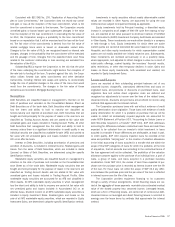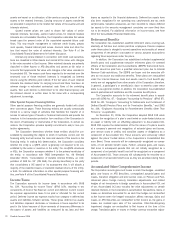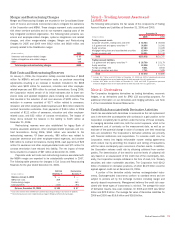Bank of America 2006 Annual Report Download - page 111
Download and view the complete annual report
Please find page 111 of the 2006 Bank of America annual report below. You can navigate through the pages in the report by either clicking on the pages listed below, or by using the keyword search tool below to find specific information within the annual report.becomes well-secured and is in the process of collection. Business card
loans are charged off no later than the end of the month in which the
account becomes 180 days past due or in which 60 days has elapsed
since receipt of notification of bankruptcy filing, whichever comes first, and
are not classified as nonperforming.
The entire balance of an account is contractually delinquent if the
minimum payment is not received by the specified due date on the
customer’s billing statement. Interest and fees continue to accrue on past
due loans until the date the loan goes into nonaccrual status, if appli-
cable. Delinquency is reported on accruing loans that are 30 days or more
past due.
Loans Held-for-Sale
Loans held-for-sale include residential mortgage, loan syndications, and to
a lesser degree, commercial real estate, consumer finance and other
loans, and are carried at the lower of aggregate cost or market value.
Loans held-for-sale are included in Other Assets.
Premises and Equipment
Premises and Equipment are stated at cost less accumulated depreciation
and amortization. Depreciation and amortization are recognized using the
straight-line method over the estimated useful lives of the assets. Esti-
mated lives range up to 40 years for buildings, up to 12 years for furniture
and equipment, and the shorter of lease term or estimated useful life for
leasehold improvements.
Mortgage Servicing Rights
Effective January 1, 2006, the Corporation early adopted SFAS 156 and
began accounting for consumer-related MSRs at fair value with changes in
fair value recorded in Mortgage Banking Income, while commercial-related
MSRs continue to be accounted for using the amortization method (i.e.,
lower of cost or market) with impairment recognized as a reduction to
Mortgage Banking Income. Certain derivatives are used as economic
hedges of the MSRs, but are not designated as hedges under SFAS 133.
These derivatives are marked to market and recognized through Mortgage
Banking Income.
Prior to January 1, 2006, the Corporation applied SFAS 133 hedge
accounting for derivative financial instruments that had been designated to
hedge MSRs. The loans underlying the MSRs being hedged were stratified
into pools that possessed similar interest rate and prepayment risk
exposures. The Corporation had designated the hedged risk as the change
in the overall fair value of these stratified pools within a daily hedge peri-
od. The Corporation performed both prospective and retrospective hedge
effectiveness evaluations, using regression analyses. A prospective test
was performed to determine whether the hedge was expected to be highly
effective at the inception of the hedge. A retrospective test was performed
at the end of the daily hedge period to determine whether the hedge was
actually effective. Debt Securities were also used as economic hedges of
MSRs and were accounted for as AFS Securities with realized gains
recorded in Gains (Losses) on Sales of Debt Securities and unrealized
gains or losses recorded in Accumulated OCI in Shareholders’ Equity. For
additional information on MSRs, see Note 8 of the Consolidated Financial
Statements.
Goodwill and Intangible Assets
Net assets of companies acquired in purchase transactions are recorded
at fair value at the date of acquisition. Identified intangibles are amortized
on an accelerated or straight-line basis over the estimated period of bene-
fit. Goodwill is not amortized but is reviewed for potential impairment on
an annual basis, or when events or circumstances indicate a potential
impairment, at the reporting unit level. The impairment test is performed in
two phases. The first step of the Goodwill impairment test compares the
fair value of the reporting unit with its carrying amount, including Goodwill.
If the fair value of the reporting unit exceeds its carrying amount, Goodwill
of the reporting unit is considered not impaired; however, if the carrying
amount of the reporting unit exceeds its fair value, an additional step has
to be performed. This additional step compares the implied fair value of
the reporting unit’s Goodwill (as defined in SFAS No. 142, “Goodwill and
Other Intangible Assets”) with the carrying amount of that Goodwill. An
impairment loss is recorded to the extent that the carrying amount of
Goodwill exceeds its implied fair value. In 2006, 2005, and 2004, Good-
will was tested for impairment and it was determined that Goodwill was
not impaired at any of these dates.
Intangible Assets subject to amortization are evaluated for impair-
ment in accordance with SFAS No. 144 “Accounting for the Impairment or
Disposal of Long-Lived Assets.” An impairment loss will be recognized if
the carrying amount of the Intangible Asset is not recoverable and exceeds
fair value. The carrying amount of the intangible is considered not recover-
able if it exceeds the sum of the undiscounted cash flows expected to
result from the use of the asset. At December 31, 2006, Intangible Assets
included on the Consolidated Balance Sheet consist of purchased credit
card relationship intangibles, core deposit intangibles, affinity relation-
ships, and other intangibles that are amortized on an accelerated or
straight-line basis over anticipated periods of benefit of up to 15 years.
There were no events or changes in circumstances in 2006, 2005, and
2004 that indicated the carrying amounts of our intangibles may not be
recoverable.
Special Purpose Financing Entities
In the ordinary course of business, the Corporation supports its custom-
ers’ financing needs by facilitating the customers’ access to different fund-
ing sources, assets and risks. In addition, the Corporation utilizes certain
financing arrangements to meet its balance sheet management, funding,
liquidity, and market or credit risk management needs. These financing
entities may be in the form of corporations, partnerships, limited liability
companies or trusts, and are generally not consolidated on the Corpo-
ration’s Consolidated Balance Sheet. The majority of these activities are
basic term or revolving securitization vehicles for mortgages, credit cards
or other types of loans which are generally funded through term-amortizing
debt structures. Other special purpose entities finance their activities by
issuing short-term commercial paper. The securities issued from both
types of vehicles are designed to be paid off from the underlying cash
flows of the vehicles’ assets or the reissuance of commercial paper.
Securitizations
The Corporation securitizes, sells and services interests in residential
mortgage loans and credit card loans, and from time to time, automobile,
consumer finance and commercial loans. The accounting for these activ-
ities is governed by SFAS No. 140, “Accounting for Transfers and Servicing
of Financial Assets and Extinguishments of Liabilities—a replacement of
FASB Statement No. 125” (SFAS 140). The securitization vehicles are
Qualified Special Purpose Entities (QSPEs) which, in accordance with SFAS
140, are legally isolated, bankruptcy remote and beyond the control of the
seller. QSPEs are not included in the consolidated financial statements of
the seller. When the Corporation securitizes assets, it may retain interest-
only strips, one or more subordinated tranches, subordinated interests in
accrued interest and fees on the securitized receivables and, in some
cases, cash reserve accounts which are generally considered residual
interests in the securitized assets. The Corporation may also retain senior
tranches in these securitizations. Gains and losses upon sale of the
Bank of America 2006
109
























